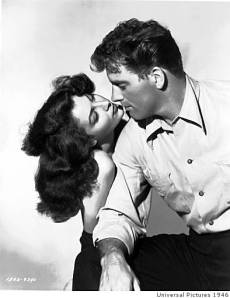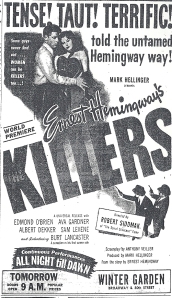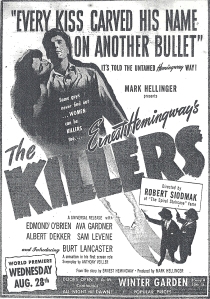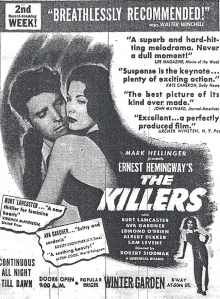This review is part of the FOR THE LOVE OF FILM: THE FILM PRESERVATION BLOGATHON to benefit the film noir foundation who work for the restoration of decaying noir films. The blogathon runs from Feb. 14th through Feb. 21st. For more information on how you can help by donating please check out our blogathon hosts, The Self Styled Siren and Ferdy on Films.
Here is a link to the organization’s facebook page.
“The Killers” is a hard-boiled film noir that starred an unknown 32-year actor making his film debut and a contract player from MGM, of limited talent, with little in her filmography at that point in time, to prove she would amount to anything. “The Killers” is intricate and visually stunning with its black blacks and pure white whites. Just take a look at the opening scene when the two killers arrive in town, the film is a dark fatalistic work of photographic beauty, a visual feast of light, darkness and shadows. Credit goes to director Robert Siodmak and cinematographer Elwood “Woody” Bredell. The opening is also enhanced by Miklos Rozsa’s music, which may sound familiar to some who remember the theme from the old TV police show “Dragnet.”
Ernest Hemingway’s short story “The Killers”, written in a hotel room in Madrid sometime in 1926, first appeared in Scribner’s Magazine in March 1927. The story is characteristic of themes that would continue to emerge in Hemingway’s work, the inescapability of death and the emptiness of life. Producer, newspaper columnist and theater critic, Mark Hellinger purchased the film rights for $36,750. Hemingway’s story is about two killers who come to the small town of Summit, Ill. (changed to Brentwood, New Jersey in the movie), looking for a man known as The Swede. Why is never said. Most of the short story takes place in Henry’s Diner where The Swede is known to come for dinner most nights. Hemingway’s story ends after Nick Adams, Hemingway perennial character, and a customer in the diner at the same time the two killers show up and announce they are going to kill The Swede, sneaks out to warn him of the two men out to kill him. The Swedes’ fatalistic resolve that there is nowhere left to run, to just remain where he is, accepting the consequences is where the short story ends. It leaves open a multitude of questions. What did The Swede do that these two guys want to kill him. Who hired them? Why has The Swede given up running readily accepting his doomed fate?
 Hellinger, working with Richard Brooks, developed the story line beyond Hemingway’s original piece. Brooks came up with the ideal of centering the story on a determined insurance investigator checking into The Swede’s death. According to Lee Server in his biography “Ava Gardner Love is Nothing“ Brooks tracked down Hemingway and asked what happened afterward, Hemingway responded, “how the hell do I know.” The screenplay was written by John Huston and Anthony Veiller, though Veiller received, sole credit due to Huston’s being under contract with Warner Brothers. Reading the short story is like reading the first ten to fifteen minutes of the script except for a few minor changes. Wisely, the screenwriters kept most of Hemingway’s hard-boiled, wise-ass dialogue in tact.
Hellinger, working with Richard Brooks, developed the story line beyond Hemingway’s original piece. Brooks came up with the ideal of centering the story on a determined insurance investigator checking into The Swede’s death. According to Lee Server in his biography “Ava Gardner Love is Nothing“ Brooks tracked down Hemingway and asked what happened afterward, Hemingway responded, “how the hell do I know.” The screenplay was written by John Huston and Anthony Veiller, though Veiller received, sole credit due to Huston’s being under contract with Warner Brothers. Reading the short story is like reading the first ten to fifteen minutes of the script except for a few minor changes. Wisely, the screenwriters kept most of Hemingway’s hard-boiled, wise-ass dialogue in tact.
After the murder of The Swede, we meet the character who could be considered the real lead of the movie, insurance investigator Jim Reardon (Edmond O’Brien). It is Reardon who puts together all the pieces of a convoluted puzzle, a story of cross and double cross, and in the middle of it all is a dame.
 Burton Lancaster made his Broadway debut (it was his first and last Broadway appearance) as Sgt. Joe Mooney in a little known play called “A Sound of Hunting” which closed after only 23 performances. Also in the cast was Sam Levene who would play Lt. Sam Lubinsky in “The Killers.” Hollywood agents, always checking out plays for new talent, were in the audience and the buzz was a new star was in the making. Enter agent Harold Hecht who was in the audience one night and came back again and again. It was the beginning of a relationship that would last for years (Lancaster and Hecht along with James Hill would later on form one of the earliest independent producing teams responsible for works that include “Apache”, “Vera Cruz”, “Marty” and “Sweet Smell of Success.”).
Burton Lancaster made his Broadway debut (it was his first and last Broadway appearance) as Sgt. Joe Mooney in a little known play called “A Sound of Hunting” which closed after only 23 performances. Also in the cast was Sam Levene who would play Lt. Sam Lubinsky in “The Killers.” Hollywood agents, always checking out plays for new talent, were in the audience and the buzz was a new star was in the making. Enter agent Harold Hecht who was in the audience one night and came back again and again. It was the beginning of a relationship that would last for years (Lancaster and Hecht along with James Hill would later on form one of the earliest independent producing teams responsible for works that include “Apache”, “Vera Cruz”, “Marty” and “Sweet Smell of Success.”).
 Mark Hellinger meanwhile was looking at actor Wayne Morris for the role of Ole “The Swede” Anderson. Morris, best remembered these days as the naive boxer in Warner Brothers “Kid Galahad” aka “The Battling Bellhop.” Morris’ career lasted until his death in 1959, was under contract to Warner Brothers who were willing to loan him to Hellinger, though for a price higher than he was willing to pay. Waiting in the dugout was newcomer Lancaster, who physically fit the role of the former boxer and Hellinger could pay a cheap salary. Suddenly, Burt Lancaster was in his very first movie and had top billing!
Mark Hellinger meanwhile was looking at actor Wayne Morris for the role of Ole “The Swede” Anderson. Morris, best remembered these days as the naive boxer in Warner Brothers “Kid Galahad” aka “The Battling Bellhop.” Morris’ career lasted until his death in 1959, was under contract to Warner Brothers who were willing to loan him to Hellinger, though for a price higher than he was willing to pay. Waiting in the dugout was newcomer Lancaster, who physically fit the role of the former boxer and Hellinger could pay a cheap salary. Suddenly, Burt Lancaster was in his very first movie and had top billing!
 At this point in her career, Ava Gardner had mostly small and uncredited roles in her résumé. She recently completed a lead role in a low budget potboiler called “Whistle Stop” with George Raft when MGM loaned her out to Universal for the role of the treacherous Kitty Collins. Gardner was not just gorgeous but managed to project a wicked lethal dose of seductive ruthlessness. The first time we see her, she is dressed in a slinky black gown standing by a piano singing. When The Swede enters the nightclub and spots her, as we do, for the first time he is captivated. Everyone else in the room, including the girl (Virginia Christine) he came with, is obliterated from his vision. It is an audience seducing moment. A weak man, falling under the spell of a duplicitous woman, and with Ava Gardner as the woman, you believed it. The role of Kitty Collins is not very large though it is central to the entire tale being told, and Lancaster and Gardner sizzle in their scenes together. When Ava Gardner went back to MGM, she went back a star.
At this point in her career, Ava Gardner had mostly small and uncredited roles in her résumé. She recently completed a lead role in a low budget potboiler called “Whistle Stop” with George Raft when MGM loaned her out to Universal for the role of the treacherous Kitty Collins. Gardner was not just gorgeous but managed to project a wicked lethal dose of seductive ruthlessness. The first time we see her, she is dressed in a slinky black gown standing by a piano singing. When The Swede enters the nightclub and spots her, as we do, for the first time he is captivated. Everyone else in the room, including the girl (Virginia Christine) he came with, is obliterated from his vision. It is an audience seducing moment. A weak man, falling under the spell of a duplicitous woman, and with Ava Gardner as the woman, you believed it. The role of Kitty Collins is not very large though it is central to the entire tale being told, and Lancaster and Gardner sizzle in their scenes together. When Ava Gardner went back to MGM, she went back a star.
 Edmond O’Brien who would become a staple in crime movies, appearing in “711 Ocean Drive”, “Brute Force”, “The Hitchhiker” and “D.O.A.,” played the determined insurance investigator, a character reminiscent, and mentioned by many others, of Barton Keyes, Edward G. Robinson’s character in Billy Wilder’s exemplary “Double Indemnity.” It is O’Brien’s character that links the multiple flashback sequences together, yet it is Lancaster’s Swede and Gardner’s Kitty Collins that are the guts of the film.
Edmond O’Brien who would become a staple in crime movies, appearing in “711 Ocean Drive”, “Brute Force”, “The Hitchhiker” and “D.O.A.,” played the determined insurance investigator, a character reminiscent, and mentioned by many others, of Barton Keyes, Edward G. Robinson’s character in Billy Wilder’s exemplary “Double Indemnity.” It is O’Brien’s character that links the multiple flashback sequences together, yet it is Lancaster’s Swede and Gardner’s Kitty Collins that are the guts of the film.
 The cast also included Sam Levene, Albert Dekker and Jeff Corey with Charles McGraw and William Conrad as the two cold-blooded killers. For Mark Hellinger, along with a great script, his choice of director and cinematographer were key to the look and success of “The Killers.” Robert Siodmak was born in Germany and came to America following his younger brother Curt. A student of German Expressionism, Siodmak fit right in with other German exiles helping create and develop the film noir style. One of his earlier films in America was “Son of Dracula” based on a screenplay by his brother, Curt. He would quickly establish himself as a master of suspense in stylish films like “The Spiral Staircase,” “Criss Cross,” “Christmas Holiday,” “The Suspect,” “Cry of the City” and “Phantom Lady.” Under contract to Universal, Hellinger wisely selected the talented Siodmak.
The cast also included Sam Levene, Albert Dekker and Jeff Corey with Charles McGraw and William Conrad as the two cold-blooded killers. For Mark Hellinger, along with a great script, his choice of director and cinematographer were key to the look and success of “The Killers.” Robert Siodmak was born in Germany and came to America following his younger brother Curt. A student of German Expressionism, Siodmak fit right in with other German exiles helping create and develop the film noir style. One of his earlier films in America was “Son of Dracula” based on a screenplay by his brother, Curt. He would quickly establish himself as a master of suspense in stylish films like “The Spiral Staircase,” “Criss Cross,” “Christmas Holiday,” “The Suspect,” “Cry of the City” and “Phantom Lady.” Under contract to Universal, Hellinger wisely selected the talented Siodmak.
When the film opened in August 1946, it was an immediate hit praised by critics and public alike. The film was so popular when it first opened in New York City; the Winter Garden Theater on Broadway ran the film twenty-four hours a day straight.
 In 1964, Universal updated and remade “The Killers.” Directed by B-film action director, Don Siegel, who was once considered to direct the original. The remake is not nearly on the same level as the original though it is still a decent film. There are a couple of reasons thatmake this film worth a look. First, this is the only film where Ronald Reagan for the first and only time in his acting career played a slimy bad dude. According Kirk Douglas in his autobiography, “The Ragman’s Son”, Reagan did not like doing this film because he had to slap femme fatale Angie Dickinson around in one scene. Dickinson, by the way, mentions in the DVD commentary that while making this film, word came about her friend, and rumored lover, President John F. Kennedy had been assassinated. Additionally, when this film was made it was initially planned to be the first original two hour made for TV movie, However, the final product was considered too violent at the time, and subsequently Universal released it instead in theaters. Finally, there is Lee Marvin, as one of the two killers (Clu Gallaghar was the other), who is the glue that holds and drives this film. The plot for this version is simplified compared to the 1946 original and less faithful to both the original film and the short story. In this version, Marvin’s character is one who is curious to know why their target (John Cassavetes) did not run, so readily accepting his doomed faith while other marks always ran. Marvin is a tough SOB. Toward the end, Angie Dickinson’s character pleads for her life. Hitman Marvin coolly aims his gun saying, ‘Lady, I don’t have the time,” killing her with one shot.Like the original, much of the story is told in flashback.
In 1964, Universal updated and remade “The Killers.” Directed by B-film action director, Don Siegel, who was once considered to direct the original. The remake is not nearly on the same level as the original though it is still a decent film. There are a couple of reasons thatmake this film worth a look. First, this is the only film where Ronald Reagan for the first and only time in his acting career played a slimy bad dude. According Kirk Douglas in his autobiography, “The Ragman’s Son”, Reagan did not like doing this film because he had to slap femme fatale Angie Dickinson around in one scene. Dickinson, by the way, mentions in the DVD commentary that while making this film, word came about her friend, and rumored lover, President John F. Kennedy had been assassinated. Additionally, when this film was made it was initially planned to be the first original two hour made for TV movie, However, the final product was considered too violent at the time, and subsequently Universal released it instead in theaters. Finally, there is Lee Marvin, as one of the two killers (Clu Gallaghar was the other), who is the glue that holds and drives this film. The plot for this version is simplified compared to the 1946 original and less faithful to both the original film and the short story. In this version, Marvin’s character is one who is curious to know why their target (John Cassavetes) did not run, so readily accepting his doomed faith while other marks always ran. Marvin is a tough SOB. Toward the end, Angie Dickinson’s character pleads for her life. Hitman Marvin coolly aims his gun saying, ‘Lady, I don’t have the time,” killing her with one shot.Like the original, much of the story is told in flashback.
The Ragman’s Son – Kirk Douglas
Ava Gardner Love is Nothing – Lee Server
Don Siegel: A Siegel Film – Don Siegel
Note: This review was originally posted on April 2009.

[…] Greco from Twenty Four Frames is back with a review of Robert Siodmak’s The Killers. We’ve been enjoying John’s posts all week. Thanks for sticking with us, […]
LikeLike
Great piece!!! The Killers remains, in my humble opinion, one of the most archetypal film noirs. It had every single element that noirs are known for, including perhaps one of the most iconic femme fatales ever seen on screen.
LikeLike
Shubhajit,
Thank you. I agree with evertyhing you say. For me, it stands as one of the best. Visually stunning thanks to Siodmak and cinematographer Woody Bredell. One to watch over and over.
LikeLike
wow! i really like your work,i’m alsowriting a blog about this subject, abit different of course! keeps up the great work.i really liked this post
LikeLike
Thanks appreciate you stopping by.
LikeLike
John, a very thorough post on one of the great film noirs and a wonderful choice for the blogathon. Siodmak was a master at this type of film in the late forties, and I think this is his masterpiece. Another interesting version of the Hemingway story is a short student film made by the Russian director Andrei Tarkovsky that follows the story closely. I saw it as an extra on the DVD of one of his other films, either “Andrei Roublev” or “The Mirror,” I don’t recall which.
LikeLike
Thank R.D.
Siodmak was one of the great directors of noir and I can go along with this as his masterpiece. If I were doing a list, and I am not, this would most likely rank up there. BTW the Tarkovsky student short in on the Criterion DVD of THE KILLERS which also includes the 1964 Don Siegel version.
LikeLike
Interesting that O’Brien is in two of possibly the most fatalistic of noirs: The one and D.O.A., both deep, dark films. I’m not always a Gardner fan, but she was ferocious in this one: “Kitty is innocent!!” is starkly feral, and Lancaster when he’s going to jump out the window, his anguished cry is from the bottom of Swede’s busted heart. Wonderful post!
LikeLike
Thanks Vanwall,
I am not a big fan of Ava Gardner either as an actress but she shows something here, a real cat like creature. O’Brien was a staple in many noir films (711 Ocean Drive, The Hitch-hiker, A Double Life) along with these two classics. He also was in some other crime films some consider noir and others don’t like White Heat, Backfire and Shield for Murder.
LikeLike
[…] John Greco caps off a week of noir coverage at Twenty Four Frames with a superlative review of Robert Siodmak’s classic The Killers: https://twentyfourframes.wordpress.com/2011/02/20/the-killers-1946-robert-siodmak-2/ […]
LikeLike
John, I read somewhere that Hemingway ended up liking The Killers best of all film adaptations of his work, presumably because it kept his core largely intact. Of course it’s a great film on its own terms and an exemplary creative adaptation of literature, though Siodmak and Lancaster would top it with Criss Cross. Having O’Brien on board here is a bonus, since he’s the definitive noir actor in my book.
LikeLike
Samuel,
Did not know that about Heminway’s affection for the film. Glad to see your high regard for “Criss Cross” a film I also admire quite a bit. I like “The Killers” a bit more but that is no knock on the latter film. Surprisingly, at least to me, neither Siodmak nor Lancaster wanted to do the film. I hope to do a review of this film within the next couple of weeks.
LikeLike
I saw The Killers again today; again I am blown away. This time by the long takes, the deep focus. Especially the Hat Factory Robbery sequence, and the shoot-up with O’Brien and the bad guys when Kitty gets away. Bredell exploited the B&W medium expertly. John, a great informative post, and I like the sidebars with associated references!
LikeLike
MSMARIEB,
Thanks very much for stopping by. It is amazing how much new insight you can get in a film watching it over and over. You know the storyline so you can concentrate on other nice touches. THE KILLIERS is one of my own favorite film noirs. Thanks again!!!
LikeLike
Excellent post, John. I plan to write about these films too. I toyed with doing a two or three part series but decided that I didn’t want to overdose my readers on the subject matter.
I’m a big Burt Lancaster fan. I think he is stunningly, exotically handsome. And of course, Ava Gardner…Wow! She is possibly the most beautiful human being ever. Neither one of them are the best actors…Lancaster can be very good, but he can also over do it, in my opinion. In The Killers, he and Gardner’s high drama works beautifully against the otherwise coldness of the film. Stellar film.
The ’64 version is good, but like you say–not of the same caliber. It was my introduction to The Killers. Lee Marvin is always good. Nobody does menacing as well. I love watching Reagan as the mob boss. Not too shabby, I must admit.
LikeLiked by 1 person
Lancaster has magnetism on screen. He is bigger than life and in the right role such as In Elmer Gantry or Seven Days in May he is terrific. However, as you mention he can over do it in other roles and ham it up. Gardner is gorgeous, not a great actress, but she makes up for it with screen presence. Lee Marvin, for me, makes the 1964 version, a cold blooded killer.
LikeLiked by 1 person
The Swede could be the biggest jerk in all film noir.The second he saw Kitty he was doomed and he even took the rap for her and spent time in jail and then went to his end.
LikeLiked by 1 person
Jay, he is a classic noir sap falling for a beautiful dame who is no good.
LikeLike